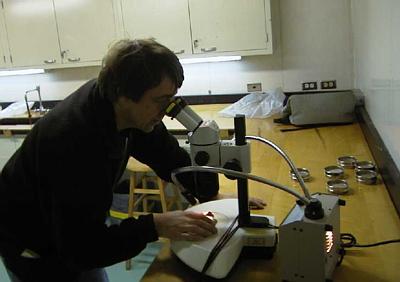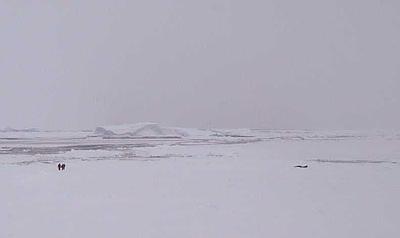9 March, 2000
Dr. Seuss Musical Instruments, and How to Tell Where an Iceberg Has Been
72 08s, 114 40 w
Temp 4 C (25 F), wind from southeast at 25 kn. (29 mph)
Barometer 981 mb, steady
In mixed ice, last shelf break station
Depth 475 m (1560 ft.)
Sometimes the very big and the very small are related. I've been
telling you some of the big things that scientists on the Nathaniel B.
Palmer are thinking about and investigating. Lately, I've been wondering if
I could help answer some of the large questions using some very small animals.
Because the Circumpolar Deep Water is relatively warm, it probably
has a strong effect on the melting of glaciers and ice shelves in
Antarctica. If ice in this part of the Antarctica melts faster than normal,
the speed of glaciers will increase, the whole West Antarctic Ice Sheet may
disappear, and sea level rise 20 feet worldwide. Stan Jacobs knows fairly
well where the warm water is now, but he doesn't know where it was in past
times. He would like to know if, for example, 1000 years ago there was warm
Circumpolar Deep Water helping melt ice shelves here. These are big questions.
One possible way to answer them is to look in sediment samples for
very small animals called foraminifers, or forams for short.
Forams are single celled marine animals that live either as
zooplankton floating in the water column, or on the bottom. Floating ones
are called planktonic forams and bottom dwellers are called benthic. In
either case, they are small, about one tenth of a millimeter across. This
is about the same size as the period at the end of this sentence. They make
shells for themselves, usually out of calcium carbonate, or out of sand
grains glued together. You can see them if you use a binocular dissecting
microscope. Planktonic forams all look more or less the same, like tiny
white shiny bulging potatoes, if you can imagine that. (Look in an advanced
Biology book, or ask your science teacher to find you a picture.) The
benthic ones take on a million different shapes. They may look like snails,
water bottles, mangoes, sausage strings, rock candy or flutes. If your
younger brothers or sisters read Dr. Seuss books, look at some of the
pictures of musical instruments in them, and you'll see some foram shapes.
I know something about forams because I studied them for a Master's Degree
at the University of Maine. Dr. Detmar Schnitker was my adviser, and I
learned a lot from him.
How can forams answer questions about where the Circumpolar Deep
Water was 1000 years ago? To put it simply, if we could find some species
of forams that only lived in the Circumpolar Deep Water, or else never
lived in it, then when we looked in a sediment core, we could tell if the
warm water was or was not there when a parcticular layer of sediment was
deposited. To find these key forams, we would look at modern sites with and
without the Circumpolar Deep Water, and see what forams are living there
right now.
Think of it this way. Supposing I want to know if it was warm or
cold in a parcticular classroom on each day for the last few weeks, and I
had no record of the temperature, just a big stack of pictures of the
classroom. There is one picture for each day, the oldest picture is at the
bottom of the stack, and the newest is at the top.
I want to study the problem, so I take a thermometer and go around
and visit various classrooms. In the first one, people are wearing
sweaters, and I measure the temperature to be 62 F. In the second one,
people are dressed in light blouses and tee shirts, and I measure the
temperature to be 71 F. I go to another one, and shiver as I come in,
because the temperature is 55 F. I find people wearing warm coats. In yet
another classroom, I see some people dressed in sweaters, and some dressed
in warm coats. I measure the temperature to be 59 F. By now I can tell what
the temperature is before I even enter the classroom, by looking through a
window at what people are wearing.
Now I go back and carefully look at my stack of pictures, and find
out what people are wearing in each one. Because I've already studied what
people wear at different temperatures, I know what temperature the
classroom was, from the picture alone. I can make a graph of the
temperature each day for as long ago as I have pictures.
The forams and Circumpolar Deep Water (CDW) would work the same
way. We would look carefully at what forams do and do not live in CDW areas
now. Then we look at a core, which is really like a stack of pictures. We
find CDW type forams in a certain layer, and we date that layer using
carbon dating. We then know that at that location at that parcticular time
the Circumpolar Deep Water was present.
That's how it would work in theory. In practice it would be a
little more difficult. To get forams out of sediment you have to very
carefully wash the mud through a fine sieve. Then under the microscope you
pick the forams from all the other parcticles, such as sand grains. You do
this by licking the tip of a very fine paintbrush and one by one picking
them up and gluing them to a special slide. Then you have to sort them out
and identify species. It takes lots of time.
There are other problems. Many other things besides water
temperature decide which forams live where, for example food supply. Also,
sometimes foram shells dissolve with time, and populations tend to vary in
different areas because benthic forams have no way of travelling long
distances.
Despite the difficulties, this type of study has been successful
in the past. You probably know that the Gulf Stream is a warm water current
that flows north along the Atlantic seaboard, and then crosses over to
Europe. North of the Gulf Stream the water is considerably colder than it
is south of it. There is a certain type of snail-shaped planktonic foram
that coils one way in warm water and one way in cold water. This foram has
been used to map the position of the Gulf Stream in past times.
Here's a question for you: There are thousands of species of
benthic forams, and less than thirty species of planktonic ones. Why?
Sometimes looking at small things very carefully can answer big
questions, but it takes time and patience.
Speaking of time and patience, I'm still ping editing for an hour
or more each day. I'm getting better at it, but it is still tedious work.
Yesterday I was editing a file, and when I got done I printed and looked at
the image the SeaBeam had drawn of the bottom. I was surprised to find big
gouges in the ocean floor, called scours. The bottoms of large icebergs
made these huge scratches as the ice moved along in the current and the
wind. I've included the SeaBeam image as an illustration with this journal
entry. There is an explanation in the caption. It takes a lot of energy to
plow a trench 20 meters deep and 75 meters wide with an iceberg, but winds
and currents exert a lot of force.
The last picture was taken from the bow of the Nathaniel B.
Palmer, and it shows two "seal people," two seals, and a few hundred acres
of pack ice. I'm going to talk to them (the people, not the seals) and find
out more about what they are doing out there. I'll let you know what they
have to say.

I'm in the Nathaniel B. Palmer's biology lab looking at forams. I tried to get you a picture of some through the scope but it didn't work out, so you will have to take my word that they are there. The little shiny cups on the counter are sieves with very fine screening, to wash the forams out of the mud.

The seal people and two Crabeater seals. The seals have lost interest in science, and are headed for an open water lead.

A SeaBeam image of part of the bottom of the Amundsen Sea, showing iceberg scours. Scours are gouges or trenches plowed up by iceberg bases dragging on the bottom. The swath imaged is about 1.6 km (1 mile) wide. The ships path is down the center of the swath. It starts in the upper left, and in the middle it makes a left hand turn and heads towards the upper right.There are several iceberg scours in this picture. The biggest one is the horizontal feature that goes across the middle, and then bends upward as it gets near the right hand edge. The bend happened when the berg changed direction. If there was no water, you would see a long trench about 75 m (246 ft) wide and 20 m (66 ft) deep. The water is about 500 m (1640 ft) deep.

The view out my cabin porthole.
Contact the TEA in the field at
.
If you cannot connect through your browser, copy the
TEA's e-mail address in the "To:" line of
your favorite e-mail package.
|
